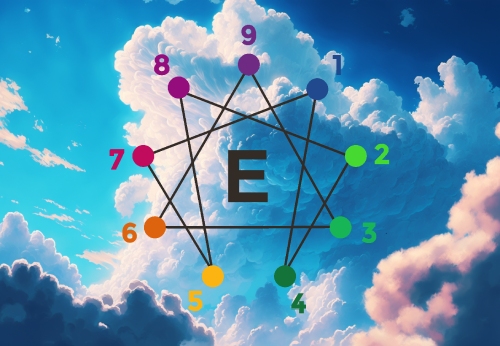
Understanding the
Enneagram
(ShortCuts)
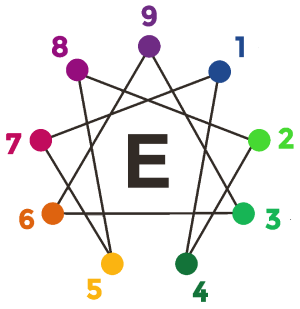
Overview
The Enneagram is a complex and nuanced personality system that represents a spectrum of nine distinct but interconnected personality types.
Each type on the Enneagram depicts a worldview and archetype that resonates with how individuals think, feel and act in relation to the world, others, and themselves.
The purpose of the Enneagram is not to put people into boxes, but to offer a path for personal growth. It’s about understanding the motivations behind our actions and how we can move toward healthier behaviors.
A brief overview of each Type:
(Click Type tiles for more info)
.webp) Type 1
Type 1
The Perfectionist/Reformer: Ethical, dedicated, and driven by a desire to live the right way, improve the world, and avoid fault and blame.
.webp) Type 2
Type 2
The Helper: Generous, people-pleasing, and driven by a desire to be loved and needed, and to avoid acknowledging their own needs.
.webp) Type 3
Type 3
The Achiever: Adaptable, excelling, driven, and image-conscious, motivated by a need to be (or appear to be) successful and to avoid failure.
.webp) Type 4
Type 4
The Individualist/Romantic: Expressive, dramatic, self-absorbed, and driven by a need to be unique, special and to express their individuality.
.webp) Type 5
Type 5
The Investigator/Observer: Perceptive, innovative, secretive, and driven by a desire to be capable and competent while avoiding incompetence.
.webp) Type 6
Type 6
The Loyalist/Skeptic: Engaging, responsible, anxious, and driven by a need for security and support, and to avoid fear and uncertainty.
 (1).webp) Type 7
Type 7
The Enthusiast: Spontaneous, versatile, distractible, and driven by a need to be happy, to plan stimulating experiences, and to avoid pain.
.webp) Type 8
Type 8
The Challenger: Self-confident, decisive, and driven by a desire to be strong and avoid feeling weak or vulnerable.
.webp) Type 9
Type 9
The Peacemaker: Receptive, reassuring, and motivated by a need for peace and harmony, and to avoid conflict and tension.
Each personality type has its own unique path of development, having distinct patterns of thinking, feeling, and behaving, as well as different motivations, fears, and desires.

Understanding Wings
In the Enneagram system, "wings" are the two adjacent types on the Enneagram diagram.
These neighboring types provide additional qualities to your primary type and can somewhat affect how you exhibit your main type's characteristics.
The theory of wings suggests that each Enneagram type is influenced by one of its neighboring types.
For example, if you're a Type 2, your wing could be a 1 or a 3. You would then be referred to as a "2w1" (Type Two with a One wing) or "2w3" (Type Two with a Three wing).
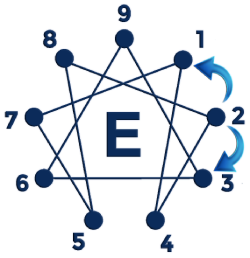
While your primary Enneagram type represents your core motivations, fears, and desires, your wing complements that type and adds important, sometimes contradictory, elements to your personality.
This makes the whole system more dynamic and nuanced, offering a more comprehensive description of human personality.
The influence of wings varies among individuals. Some people might strongly relate to one of their wings, almost equally as they do to their core type.
Others might relate minimally to their wings. It's also important to note that people can't have a wing of a type that isn't directly adjacent to their core type. For example, a Type 4 can't have a 7 wing.

A brief overview of how wings can influence each type:
.webp)
Type 1 - The Perfectionist:
With a 9 wing (1w9), they may be more calm, receptive and perhaps a bit detached. With a 2 wing (1w2), they may be more outgoing, helpful, and people-oriented.
.webp)
Type 2 - The Helper:
With a 1 wing (2w1), they may be more perfectionistic, idealistic, and driven. With a 3 wing (2w3), they may be more ambitious, image-conscious, and charming.
.webp)
Type 3 - The Achiever:
With a 2 wing (3w2), they may be more sociable, altruistic, and image-oriented. With a 4 wing (3w4), they may be more introverted, individualistic, and focused on authenticity.
.webp)
Type 4 - The Individualist:
With a 3 wing (4w3), they may be more ambitious, extroverted, and desire to be noticed. With a 5 wing (4w5), they may be more introverted, intellectual, and idiosyncratic.
.webp)
Type 5 - The Investigator:
With a 4 wing (5w4), they may be more creative, introspective, and concerned with self-expression. With a 6 wing (5w6), they may be more loyal, anxious, and cooperative.
.webp)
Type 6 - The Loyalist:
With a 5 wing (6w5), they may be more introverted, intellectual, and serious. With a 7 wing (6w7), they may be more sociable, playful, and desiring of fun experiences.
 (1).webp)
Type 7 - The Enthusiast:
With a 6 wing (7w6), they may be more playful, loyal, and anxious. With an 8 wing (7w8), they may be more assertive, intense, and desire to exert control over their environment.
.webp)
Type 8 - The Challenger:
With a 7 wing (8w7), they may be more extroverted, adventurous, and desiring of new experiences. With a 9 wing (8w9), they may be more calm, patient, and supportive.
.webp)
Type 9 - The Peacemaker:
With an 8 wing (9w8), they may be more assertive, forceful, and protective. With a 1 wing (9w1), they may be more idealistic, orderly, and detail-oriented.
Understanding your wing can provide additional insight into your motivations, behavior, and strategies for personal growth.
Sp, So, Sx
The Enneagram Subtypes
In addition to the Wing element, each of the nine Enneagram types has three subtypes, making for a total of 27 distinct subtype personalities.
These subtypes are based on how the basic instinct (also known as the instinctual variant) combines with the main Enneagram type.
Each of the nine Enneagram types can exhibit all three of these instincts, but one is typically dominant and has a significant influence on the individual's motivations and behaviors.
The three basic instincts are usually defined as follows:
Self-Preservation (Sp): This instinct is about the drive for personal safety, comfort, and well-being. People with this dominant instinct might focus on health, finance, and security issues more than others.
Social (So): This instinct is about the individual's place within a group or community. Individuals with a dominant social instinct tend to focus on their interactions, relationships, and the dynamics within their social groups.
Sexual (Sx): Also referred to as "one-to-one" or "intimate", this instinct drives the individual toward intense experiences, connections, and activities that lead to personal transformation. Despite the name, it's not exclusively about sexual experiences but about the intensity of experience more generally.
Subtype Examples
.webp)
Exploring the Sub Types
through the Lens of the Type 4.
As per the Enneagram theory, every type can be influenced by one of the three basic instincts: Self-Preservation, Social, or Sexual (One-to-One), resulting in three subtypes for each Enneagram type.
Self-Preservation Type 4 (4sp)
"The Sensualist":
Known as "The Sensualist" or "Tenacity," this subtype is typically more focused on creating a unique and comfortable environment. They often use their resources and possessions as a means to express their individuality and uniqueness. They may also have a strong focus on personal aesthetics and a unique style of dress. They may be more introverted, and their need for emotional intensity might be experienced more internally.
Social Type 4 (4so):
"The Outsider":
Referred to as "The Outsider" or "Shame," these individuals express their individuality within social groups and may often feel a sense of not fitting in or being different from others. They may take on unique roles or positions in their social groups, seeking to contribute something special or unique. They can also be more aware of social hierarchy and may struggle with feelings of envy related to their perceived social status.
Sexual Type 4 (4sx)
"Competition":
Often called "Competition" or "Intensity," these individuals desire deep, intimate connections with others and tend to be the most intense and dramatic subtype of type 4. They may express their uniqueness through intense emotional experiences and passionate relationships. Their longing for what they perceive as missing can make them more likely to idealize others and experience a sense of competition.
These subtypes reflect how the basic instinct combines with the core motivations, fears, and desires of Type 4, leading to different expressions of the same core type.
It's important to remember that people are complex and multidimensional, and their behaviors and attitudes can be influenced by many factors beyond their Enneagram type and subtype.
Triads
.webp)


The Gut, Heart, and Head
The Enneagram system can also be understood through the concept of "Triads" or "Centers," which group the nine types into three categories based on how each type tends to respond or react to the world.
This concept contributes to the depth and complexity of the Enneagram system. The three triads are generally referred to as the Instinctive (or Gut) Triad, the Feeling (or Heart) Triad, and the Thinking (or Head) Triad.
.webp)
The Gut Triad
(Types 8, 9, 1):
This triad is defined by a primary relationship to anger and autonomy, dealing with issues of control and power. They relate to the world through their instinct and gut feelings. Type 8 externalizes their anger, Type 9 forgets or denies their anger, and Type 1 internalizes their anger.

The Heart Triad
(Types 2, 3, 4):
This triad's primary emotional theme is shame, and they focus on issues of identity, significance, and worthiness. They tend to respond to the world through feelings and emotions. Type 2 externalizes their feelings, Type 3 is disconnected from their feelings, and Type 4 internalizes their feelings.

The Head Triad
(Types 5, 6, 7):
The types in this triad tend to cope with fear and anxiety. They try to find security and relate to the world through thinking and planning. Type 5 internalizes fear, Type 6 externalizes fear, and Type 7 forgets or denies fear.
In each triad, the emotional response (anger, shame, or fear) can be over-expressed, under-expressed, or disconnected from. The concept of the triads offers another layer of insight into how individuals of each type tend to process their experiences and emotions.
It's important to remember that each Enneagram type has access to the resources and challenges of all three centers, but they tend to habitually prefer or overuse one center over the others.
The History
of the Enneagram:
From Ancient Roots to Modern Psychology
.webp)
Origins of the Enneagram:
Although its origins are shrouded in mystery, the Enneagram is widely believed to have a long and complex history that spans various cultures and regions, rooted in diverse mathematical, philosophical, and spiritual traditions.
One claim suggests that the Enneagram has roots in Egypt, specifically from early Christian monastics or "Desert Fathers" who lived in the Egyptian desert in the 4th and 5th centuries.
Some believe it to be influenced by Pythagorean number mysticism and was used in various mystical traditions. Pythagoras.
The Enneagram Symbol:
.jpg)
The term "Enneagram" derives from the Greek words "ennea" meaning "nine" and "gram" meaning "model," "points," or "that which is written or drawn."
The Enneagram framework, therefore, consists of nine interconnected points or types that represent different personality traits or patterns. The Enneagram symbol itself, a nine-pointed geometric figure within a circle, appears to have ancient origins.
Known Contributors:
Ramon Llull and the Early Conceptions of Nine-fold Systems
.webp)
Ramon LLull
In the 13th century, Ramon Llull, the "beatified" philosopher and logician from the Kingdom of Majorca, worked extensively on combinatorial systems and metaphysics, creating diagrams of elements and principles that some scholars suggest might be an early precursor to the Enneagram. While Llull's work does not explicitly feature the Enneagram symbol or its typology, his exploration of permutations and combinations of elements and principles resonate with the interconnectedness and dynamism of the Enneagram. Ramon Llull - Wikipedia
George Gurdjieff and the Introduction to the West
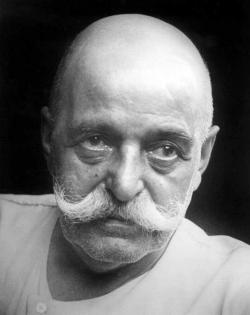
George Gurdjieff
Fast forward to the early 20th century, the Enneagram was introduced to the West by George Gurdjieff, an Armenian philosopher and spiritual teacher. Gurdjieff's use of the Enneagram was not tied to personality types, but instead, he utilized it as a cosmological diagram mapping universal processes and the law of seven and the law of three. George Gurdjieff - Wikipedia
Oscar Ichazo and the Birth of the Enneagram of Personality
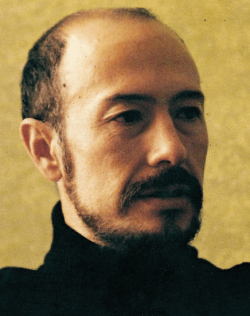
Oscar Ichazo
The Enneagram as we understand it today, a system for comprehending human personality, was developed by Oscar Ichazo in the mid-20th century. Ichazo, a Bolivian philosopher, was the first to associate the Enneagram symbol with nine distinct personality types, linking each point to specific ego fixations, passions, virtues, and holy ideas. Oscar Ichazo - Wikipedia
Claudio Naranjo's Psychological Developments
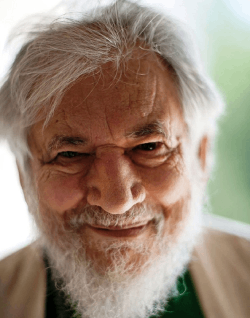
Claudio Naranjo
Chilean psychiatrist Claudio Naranjo expanded upon Ichazo's teachings in the 1970s. He brought the Enneagram to the United States and added specific psychological characteristics, pathologies, and defense mechanisms to each of the nine types. Naranjo also introduced the concept of "wings," suggesting that our primary type could be influenced by one of its neighboring types on the Enneagram. Claudio Naranjo - Wikipedia
The Expansion and Modern Usage of the Enneagram
Following Naranjo, the Enneagram system continued to evolve and expand as various students and scholars added their insights and understanding. Notable figures like Don Riso and Russ Hudson, Helen Palmer, and Fr. Richard Rohr have enriched the body of knowledge around the Enneagram.

Fr. Richard Rohr
Richard Rohr, a Franciscan friar, is a significant figure in the modern development of the Enneagram and has written extensively on the subject. He sees the Enneagram as a powerful spiritual tool for self-understanding and personal transformation.
Rohr asserts that the Enneagram illuminates the "shadow side" of our personality. He believes that each of us is driven by a specific passion, or a fundamental way in which we stray from our true self. By understanding our Enneagram type, we can recognize this passion and the patterns of behavior that stem from it. This awareness, Rohr suggests, can lead to spiritual growth and a journey towards wholeness.
He emphasizes that the Enneagram does not put people into boxes but rather reveals the box we are already in and the way out of it. He sees the Enneagram as a map to understanding our soul and finding our true self, differentiating between our true self (our essence or who we are in God) and our false self (our ego or who we have learned to be in the world).
Furthermore, Rohr posits that our greatest strength is also our greatest weakness. Each type's particular gift is what makes them special, but when overused or misused, it becomes their downfall. He suggests that the Enneagram can help us balance our strengths so they don't become our weaknesses.
Rohr has co-authored the book "The Enneagram: A Christian Perspective" with Andreas Ebert, where they delve into each of the nine types in detail from a Christian viewpoint. They examine how the Enneagram can be used for personal transformation, looking at the virtues, vices, and other spiritual implications of each type.
Rohr's teachings on the Enneagram are an integration of psychology, spirituality, and theology. He sees it as a path to compassion, understanding, and love for oneself, others, and God.
You can find more about Richard Rohr's works and his views on the Enneagram on his organization's website, the Center for Action and Contemplation, as well as his many books and recorded teachings.
Today, the Enneagram is used widely for personal growth, spiritual development, understanding human behavior and relationships, and in various professional contexts for enhancing teamwork and communication.
|

Ben Baker, CEO
About the Author
Ben has practiced Astrology for over 35 years and is a certified Cognitive Behavioral Therapist (CBT) Practitioner. Ben holds 11 patents for the core functions that all dating sites now use today. See Ben's Bio for more info.
|












.webp)
.webp)
.webp)
.webp)
.webp)
.webp)
 (1).webp)
.webp)
.webp)



.webp)
.webp)


.webp)


.webp)
.jpg)
.webp)





Comments